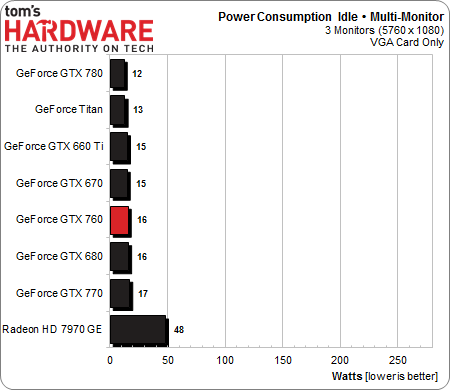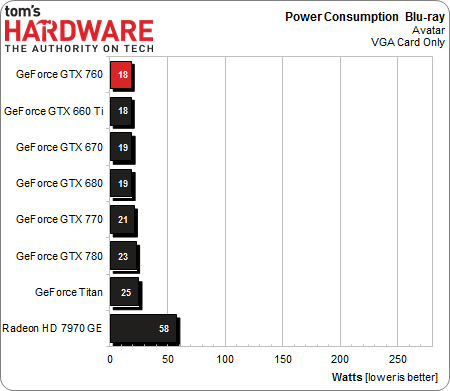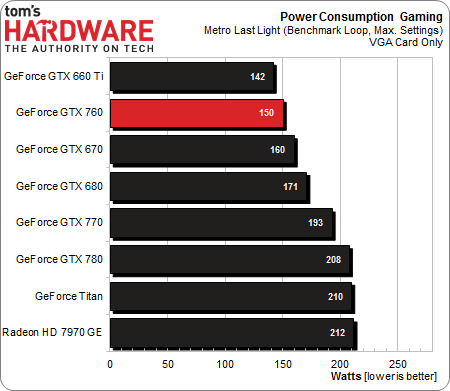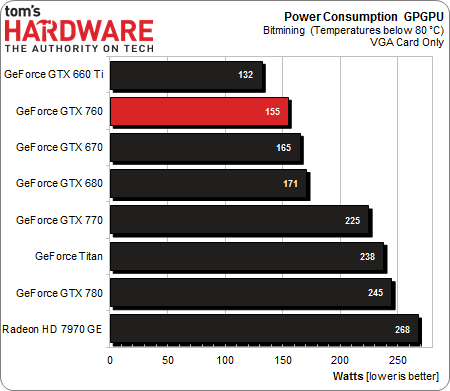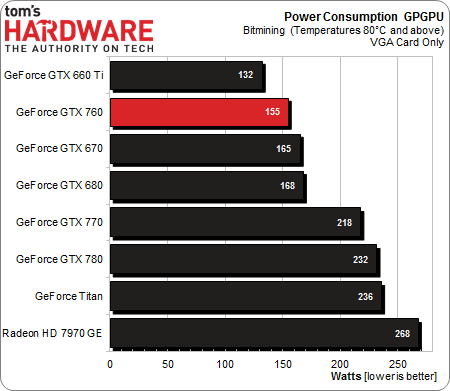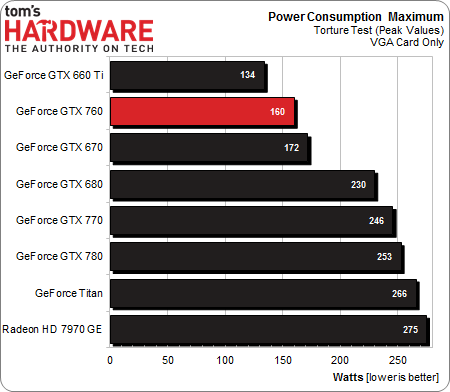GeForce GTX 760 Review: GK104 Shows Up (And Off) At $250
With its last graphics card introduction until the end of Fall, Nvidia isn't trying to impress anyone with groundbreaking performance. Rather, the company is pulling better-than GeForce GTX 660 Ti-class frame rates to a $250 price point, creating value.
Power Consumption
All measurements are taken directly from each card, since monitoring system-level consumption is not exact enough. After all, different graphics loads affect processor utilization, causing platform power to fluctuate.
Of course, we are especially interested in a direct comparison between the GeForce GTX 660 Ti, GeForce GTX 670, and the new GeForce GTX 760, since all three models compete against each other, albeit indirectly.
At the outset, all cards behave similarly.
Stepping up to a gaming workload reveals greater differences, although the new GeForce GTX 760 once more falls between the GeForce GTX 660 Ti and the GeForce GTX 670. That makes sense, considering its clock rate. Factory-overclocked versions of the 760 come much closer to the GeForce GTX 670 both in power consumption and performance.
In compute-intensive applications, the GeForce GTX 760's power consumption tends closer to the 670 than the 660 Ti, even at stock clocks. Considering the new card’s mixed performance in our CUDA and OpenCL testing, that’s not really justified. The GeForce GTX 760 never hits its thermal or power targets, so our 80-degree scenario only becomes a limiting factor for the higher-end cards.
As long as the GPUs don't exceed their rated thermal or power limits, they hit power peaks beyond Nvidia's TDP. In practice, this happens very rarely, and only briefly at that. Still, don’t forget to take those situations into account and pick your power supply accordingly.
Get Tom's Hardware's best news and in-depth reviews, straight to your inbox.
Current page: Power Consumption
Prev Page OpenCL: Double-Precision Next Page Cinching Up Mainstream Gaming With GeForce GTX 760-
SiliconWars This doesn't look faster than the 7950 boost to me. Maybe you should check your scores and update your conclusion to reflect reality?Reply -
pauldh Reply11035777 said:This doesn't look faster than the 7950 boost to me. Maybe you should check your scores and update your conclusion to reflect reality?
Re-read the conclusion in question below. He doesn't say it is faster, he says this card will replace Don's recommendation for best $250 card and displace the 7950 Boost. ie. Don won't be recommending a $300 card that trades blows or barely beats a $250 card. If both were to end up $250, things change.
quote - "A quick reference to Best Graphics Cards For The Money: June 2013 shows that Don is currently recommending the Tahiti-based Radeon HD 7870 for $250. With almost certainty, the GeForce GTX 760 will take that honor next month, displacing the Radeon HD 7950 with Boost at $300 in the process." -
mapesdhs Chris, what is it about the GTX 580 that makes it so slow for the CUDA FluidmarkReply
test, given it does so well for the other CUDA tests, especially iRay and Blender?
Btw, I don't suppose you could include 580 SLI results for the game tests? ;)
Or do you have just the one 580?
My only gripe with the 760 is the misuse of a model number which allows one to
infer it should be quicker than older cards with 'lesser' names (660, etc.) when
infact it's often slower. I really wish NVIDIA would stop releasing products that
exhibit such enormous performance overlap. Given the evolutionary nature of
GPUs, and the time that has passed since the 600s launched, one might
reasonably expect a 760 to beat the 670 too, but it never does. To me, the
price drop is the only thing it has going for it. The endless meddling with shader
numbers, clocks, bus width, etc., creates an utter muddle of performance
response depending on the game. One really has to judge based on the
individual game rather than any general product description or spec summary.
I just hope Skyrim players with 660s don't upgrade on the assumption newer
model names mean better performance, but I expect some will.
Ian.
-
tomfreak GTX760 is an upgrade for GTX460/560 user and of all of that u didnt throw in those cards to bench with. Seriously?Reply -
Novuake Nice review as per usual Chris.Reply
Amazing performance at 250$. The 265bit memory interface does wonders for GK104.
Now I am wondering if there will even be a GTX760ti, while there is a large enough gap in the product stack, I have a feeling there is a chance there may not be a "ti" version.
Anyone know more? -
sarinaide AMD will have to release a new interim Radeon series, the existing family is not to outdated to be stretched to much longer.Reply -
horaciopz So, maybe there will be an GTX 760 ti, for about 300 bucks with the peformance of a GTX 670... Uh? nVidia really should. This remembers the gtx 400 series and 500 series... nVidia is doing it all over again.Reply

